In reviewing the military file of Robin W.G. Stephens, I came across several references to Abyssinia and/or Ethiopia. On his application file, Stephens was asked: Have you an intimate knowledge of any parts of the British Empire, and/or Foreign Countries?
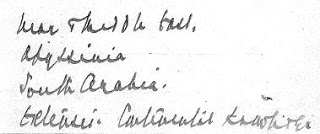
His handwriting is a bit of a cipher but it appears to read:
Near & Middle East,
Abyssinia,
South Arabia,
Extensive Continental Knowledge.
After the war, Robin’s father wrote a letter to the War Office seeking information on the whereabouts of his son. He provided a resume of his son’s career and noted that Stephens had:
- served as Adjutant to British Red Cross Expedition to Ethiopia during Italo-Abyssinian War
- been invalided home from Abyssinia to the Masonic Hospital, Ravenscourt
This provides us with a bit more information, and a date range (Italo-Abyssinian War), for Stephens’ time in Abyssinia/Ethiopia. Stephens’ father also quoted a letter:
From: Mr. J. Melly, F.R.G.S. [sic] etc. Principal Medical Officer, British Red Cross in Ethiopia
To: Sir Harold Fawcus K.C.B. etc. Director of the British Red Cross Society in London Dated 1st of December 1936 [sic]
“As I have had frequent occasion to report, I consider Captain Stephens to be, without exception, the only really indispensable member of the Red Cross in Ethiopia.
Coupled with real capability is a capacity for hard and conscientious work I have seldom seen equalled.
I consider that his work as Administrative Officer has been fully twice as hard and unending as that of any other official, and that the Committee would be hard put to it to find another Administrative Officer with half his capabilities or devotion to duty.”
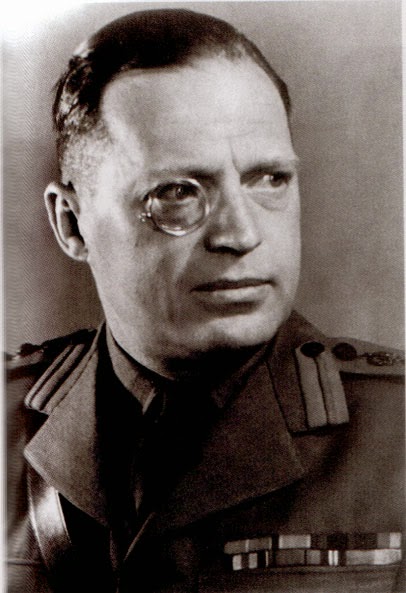
High praise indeed and one more bit of evidence that confirms that Stephens served with the British Red Cross in Abyssinia/Ethiopia during the mid-1930s.
John Melly did indeed serve with the British Red Cross expedition in Ethiopia. Born in Liverpool in 1898, André John Mesnard Melly enlisted in 1917 and served with the Royal Field Artillery. He was awarded the Military Cross and finished the war as a Second Lieutenant. After the war, Melly studied medicine in Liverpool and became a surgeon and a member of the Fellowship of the Royal Colleges of Surgeons (FRCS). A passionate Christian, Melly dreamed of combining his two passions (faith and medicine) and becoming a medical missionary. Stephens himself would later describe Melly “as intensely, but unobtrusively religious”. After a visit to Ethiopia in early 1935, Melly recognized the signs of looming war and returned to Britain where he founded the British Ambulance Service in Ethiopia (BASE). Initially funded to a large extent out of his own pocket, BASE eventually became integrated with the British Red Cross.
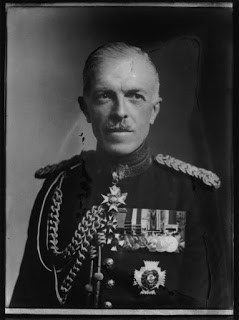
As for the recipient of the letter written by Melly regarding Stephens, Sir Harold Ben Fawcus was indeed the Director General of the British Red Cross. Fawcus was an experienced officer who had served with the Royal Army Medical Corps (RAMC) since 1900. He was mentioned six times in despatches during the First World War and even spent time along the north-west frontier of India during the third Afghan War in 1919, making one wonder if he had encountered Stephens at that point.
A bit of digging on the internet has yielded several references to Stephens in relation to Ethiopia. At this point, some context, and a brief history lesson, is in order for those who, like me, have no clue about the Italo-Abyssinian War. Before we begin, I should mention that at this point in his life, Stephens was still sometimes hyphenating his name with that of his wife – “Townshend-Stephens” – see my blog post of Phyllis Gwendolen Townshend for more information.
The First Italo-Ethiopian War
It all began with the jockeying for position of European colonizers in Africa. The big players, England and France, weren’t all that pleased when the other acquired an advantage in the race for colonies, particularly locations of strategic importance. The first Italo-Abyssinian War took place in 1895-1896 as part of Italy’s bid to establish a colonial foothold in Africa. The Ethiopian Empire (also known as Abyssinia) was one of the few regions that had remained independent as European colonizers subjugated the rest of Africa. Italy on the one side, was supported by England, Germany and Austria-Hungary while Ethiopia was supported by the French and the Russians. After early losses, the Ethiopians gave the Italians a serious trouncing and emerged victorious, much to the chagrin of the Italians. The Treaty of Addis Ababa forced Italy to recognize the independence of Ethiopia. But the Italians never forgot the humiliation of their losses at the hands of the Ethiopians.
The Second Italo-Ethiopian War
By the early 1930s, the Italians were again eyeing Ethiopia with a view to bringing it under their control. They had tried “peaceful” infiltration and not met with much success. By late 1934, Mussolini had ordered the military invasion of Ethiopia. Both England and France, preferring to keep Italy as a buffer against Nazi Germany, turned a blind eye to the build-up of troops along the Ethiopian border. They didn’t want to antagonize the Italians who were already a bit too friendly with Nazi Germany.
On 3 October, 1935, Italian forces invaded Ethiopia from Eritrea, and the war was on. All of this took place despite the fact that both Italy and Ethiopia were members of the League of Nations. It would appear that the League of Nations turned a blind eye to Italy’s invasion of Ethiopia, despite the fact that the invasion was a clear violation of Article X of the Covenant of the League of Nations. (Article X called for assistance to be given to a member that experienced external aggression.)
At the outbreak of war, the International Red Cross encouraged both sides to uphold the provisions of the Geneva Convention which protected the wounded and sick and, since 1929, prisoners of war. Ethiopia agreed to sign the Convention on sick and wounded but the Ethiopian Emperor declined to accept the treaty covering prisoners of war. Both sides, however, were bound by the 1925 Protocol which prohibited the use of poison gas.
As the war raged, both Italy and Ethiopia committed war atrocities. The Ethiopians tortured and mutilated Italian prisoners of war while the Italians, in retaliation, used mustard gas and bombed field hospitals set up by the British and Swedish Red Cross. In early 1936, Dr. Marcel Junod, a Swiss doctor with the Red Cross, noted:
“That evening [18 March 1936] I had occasion to see with my own eyes an Italian aircraft spraying the ground with an oily liquid, dropping like fine rain and covering a huge area with thousands of droplets, each of which, when it touched the tissues, made a small burn, turning a few hours later into a blister. It was the blistering gas the British call mustard gas. Thousands of soldiers were affected by severe lesions due to this gas…” (ICRC – Ethiopia 1935-36)
R.W.G. Stephens and Mustard Gas
Italy’s use of mustard gas in the early months of 1936 created quite a furor. There were numerous newspapers reports from early April 1936. A Times correspondent reporting from Ethiopia reported that:
“I witnessed during the subsequent three weeks, at Quoram [Korem] and Ashangi [Ashenge], almost daily bombardments, accompanied by the spraying of mustard gas, against which only a diving dress could give complete protection. Abyssinian soldiers, peasants, women and children are receiving ghastly burns, covering their heads and shoulders. Captain Townshend Stephens and Dr. Empey, who went to the assistance of Warrant Officer Atkinson, to help him treat 100 victims passed through the zone of mustard gas and showed marked effects from it.” (Sydney Morning Herald, 6 April 1936, page 9)
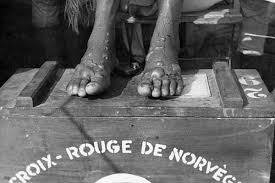
The Times correspondent was quite incensed when he read a report that “members of the House of Lords hoped that the allegations regarding the Italian use of poison gas were untrue”. He wonderingly contemplated “the marvels of that world [Europe] where facts dissolve into speculation. Poison gas has for months been a brutal reality for soldiers on the northern front and for peasants in the bush.” (Sydney Morning Herald, 6 April 1936, page 9)
The New Zealand Herald had the same report by the Times Correspondent but also quoted Stephens directly:
“Captain Townshend Stephens, a British Red Cross official, on his return to Addis Ababa from the front, describes the terrors of gas in the Quoram [Korem] region as the cruelest form of butchery. He states that thousands of helpless men, women and children are suffering from horrible festering boils and sores which gas has produced.
‘We have treated about 3000 patients in the past month,’ said Captain Stephens, ‘of whom about 20 in every 1000 have died, but hundreds of those affected do not reach medical aid. Gas, sprayed from an apparatus affixed to the wings of aeroplanes, descends like invisible dew and the victims are not aware of being affected until an hour after the raid. Babies succumb almost immediately.’ ” (New Zealand Herald, 6 April 1936, page 11)
A later report by the Stockholm International Peace Research Institute adds some details to Stephens encounter with mustard gas:
“Another case of injury by gas occurred when the British Ambulance officers, Captain Townshend Stephens and Dr. Empey, went to the assistance of the crew of an Ethiopian Red Cross plane which had been bombarded by the Italians while lying on the open ground at Kworam [Korem]. The officers found themselves passing through a zone of mustard gas and both shortly afterwards showed marked indications of inhalation of the vapour, while Captain Townshend Stephens suffered slight but distinct burns on the throat. Among the wounded, who during Mr. Holmes’ stay in the region of Kworam [Korem] were streaming back from the battles south of Makale [Mekelle] and in the Tembien, there were a great proportion of gas victims. Many were suffering from gangrened wounds due to the lack of facilities and materials for treating the effects of gas at the front.” (SIPRI, p. 182)
Stephens, too, apparently wrote about his experiences in an article published in St. Bartholomew’s Hospital Journal (see references below). In one instance, in order to escape the bombing by Italian aircraft, the British Red Cross moved one of their field hospitals into a cave. It was tight, cramped quarters, damp and infested with fleas. During air raids, the local population fled to the cave and Stephens noted that while the new field hospital was bombproof, ‘it was a sad failure as a hospital’. (quoted in Between Bombs and Good Intentions, p. 169 – see references below) One wonders if Stephens’ experience in Ethiopia perhaps coloured his perception of the Italians, for he would later write that Italians are “undersized, posturing folk”.
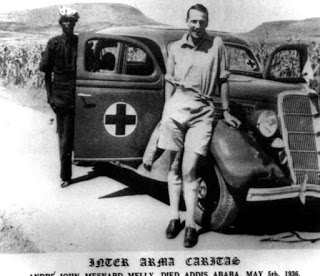
Stephens’ father noted that Robin had been invalided home from Abyssinia in 1936. It is unclear if this was due to the effects of mustard gas or from other injuries.
Dr. John Melly, the leader of the British Red Cross Expedition to Ethiopia would not be so lucky. He died in Addis Adaba on 5 May 1936 after being shot in the lung during a riot in the city while treating a patient in the street. Given that Stephens’ father references a letter by Melly dated 1 December 1936 (after Melly died), one wonders if perhaps the date on the letter should have been 1 December 1935. Or perhaps the letter was sent posthumously after being found in Melly’s files. Before his death, Melly was emphatic about the use of mustard gas by the Italians:
This isn’t a war — it isn’t even a slaughter — it’s the torture of thousands of defenceless men, women and children, with bombs and poison gas.”
Sources
International Committee of the Red Cross – Ethiopia 1935-36: mustard gas and attacks on the Red Cross
International Committee of the Red Cross – Force versus law: The International Committee of the Red Cross and chemical warfare in the Italo-Ethiopian war 1935-1936
The Problem of Chemical and Biological Warfare – Volume IV – CB Disarmament Negotiations, 1920-1970 – SIPRI – Stockholm International Peace Research Institute
Between Bombs and Good Intentions: The International Committee of the Red Cross (ICRC) and the Italo-Ethiopian war, 1935-1936 (Human Rights in Context) (2006) – Rainer Baudendistel
Townshend-Stephens, Captain R. ‘John Melly or the British Ambulance Service in Ethiopia’, St. Bartholomew’s Hospital Journal, London, September, 1936, volume 43, p. 223-30.
National Portrait Gallery – Sir Harold Ben Fawcus KCB CMG DSO DCL MB KHP, former Director General of the Army Medical Services (1929-1934) and former Director General of the British Red Cross (1934-1938)
Journal Royal Army Medical Corps – obituary of Sir Harold Ben Fawcus (link should open as a pdf)
Post Script

(from Access London website)
If anyone ever gets over to St. Bartholomew’s Hospital Archives & Museum in West Smithfield, London, the reference for Stephens’ journal article is: SBHMS/PB/1/42 – although it appears one needs to email ahead of time to make an appointment to visit/view the archives.
Post Post Script
Thanks to Tony K and Stephen D for helping to decipher Stephens’ scrawls.
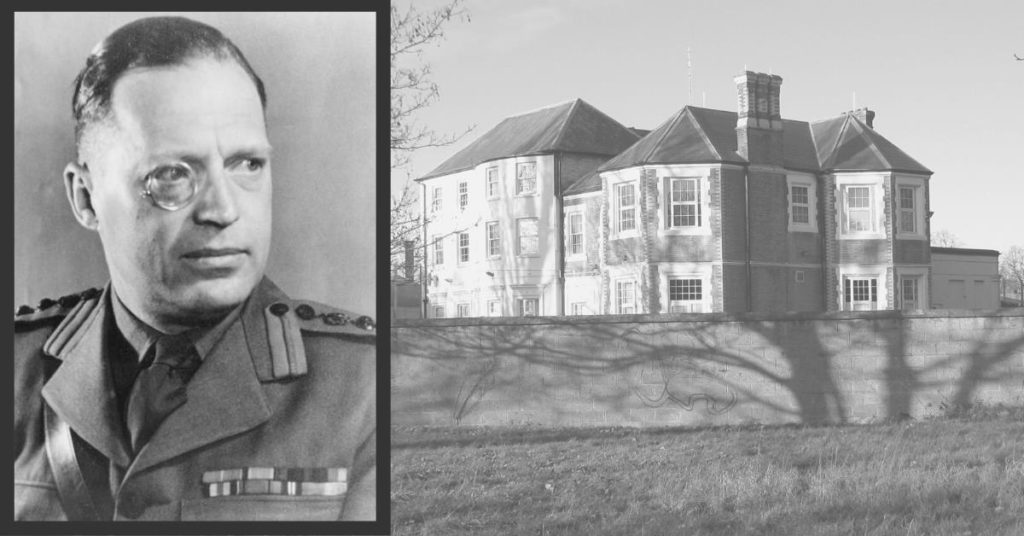
I think the word in RWGS's handwriting is 'extensive'.
I may be able to visit the Bart's archive to get a copy of his article.
I think you're right – I'll make the changes – thanks so much.
And much indebted if you can get to the Bart's archives!